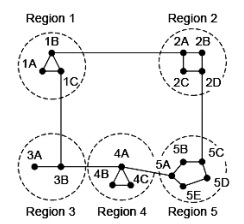
 Data Structure
Data Structure Networking
Networking RDBMS
RDBMS Operating System
Operating System Java
Java MS Excel
MS Excel iOS
iOS HTML
HTML CSS
CSS Android
Android Python
Python C Programming
C Programming C++
C++ C#
C# MongoDB
MongoDB MySQL
MySQL Javascript
Javascript PHP
PHP
- Selected Reading
- UPSC IAS Exams Notes
- Developer's Best Practices
- Questions and Answers
- Effective Resume Writing
- HR Interview Questions
- Computer Glossary
- Who is Who
What is hierarchical routing?
In hierarchical routing, the routers are divided into regions. Each router has complete details about how to route packets to destinations within its own region. But it does not have any idea about the internal structure of other regions.
As we know, in both LS and DV algorithms, every router needs to save some information about other routers. When network size is growing, the number of routers in the network will increase. Therefore, the size of routing table increases, then routers cannot handle network traffic as efficiently. To overcome this problem we are using hierarchical routing.
In hierarchical routing, routers are classified in groups called regions. Each router has information about the routers in its own region and it has no information about routers in other regions. So, routers save one record in their table for every other region.
For huge networks, a two-level hierarchy may be insufficient hence, it may be necessary to group the regions into clusters, the clusters into zones, the zones into groups and so on.
Example
Consider an example of two-level hierarchy with five regions as shown in figure −

Let see the full routing table for router 1A which has 17 entries, as shown below −
Full Table for 1A
| Dest. | Line | Hops |
|---|---|---|
| 1A | - | - |
| 1B | 1B | 1 |
| 1C | 1C | 1 |
| 2A | 1B | 2 |
| 2B | 1B | 3 |
| 2C | 1B | 3 |
| 2D | 1B | 4 |
| 3A | 1C | 3 |
| 3B | 1C | 2 |
| 4A | 1C | 3 |
| 4B | 1C | 4 |
| 4C | 1C | 4 |
| 5A | 1C | 4 |
| 5B | 1C | 5 |
| 5C | 1B | 5 |
| 5D | 1C | 6 |
| 5E | 1C | 5 |
When routing is done hierarchically then there will be only 7 entries as shown below −
Hierarchical Table for 1A
| Dest. | Line | Hops |
|---|---|---|
| 1A | - | - |
| 1B | 1B | 1 |
| 1C | 1C | 1 |
| 2 | 1B | 2 |
| 3 | 1C | 2 |
| 4 | 1C | 3 |
| 5 | 1C | 4 |
Unfortunately, this reduction in table space comes with the increased path length.
Explanation
Step 1 − For example, the best path from 1A to 5C is via region 2, but hierarchical routing of all traffic to region 5 goes via region 3 as it is better for most of the other destinations of region 5.
Step 2 − Consider a subnet of 720 routers. If no hierarchy is used, each router will have 720 entries in its routing table.
Step 3 − Now if the subnet is partitioned into 24 regions of 30 routers each, then each router will require 30 local entries and 23 remote entries for a total of 53 entries.
Example
If the same subnet of 720 routers is partitioned into 8 clusters, each containing 9 regions and each region containing 10 routers. Then what will be the total number of table entries in each router.
Solution
10 local entries + 8 remote regions + 7 clusters = 25 entries.

